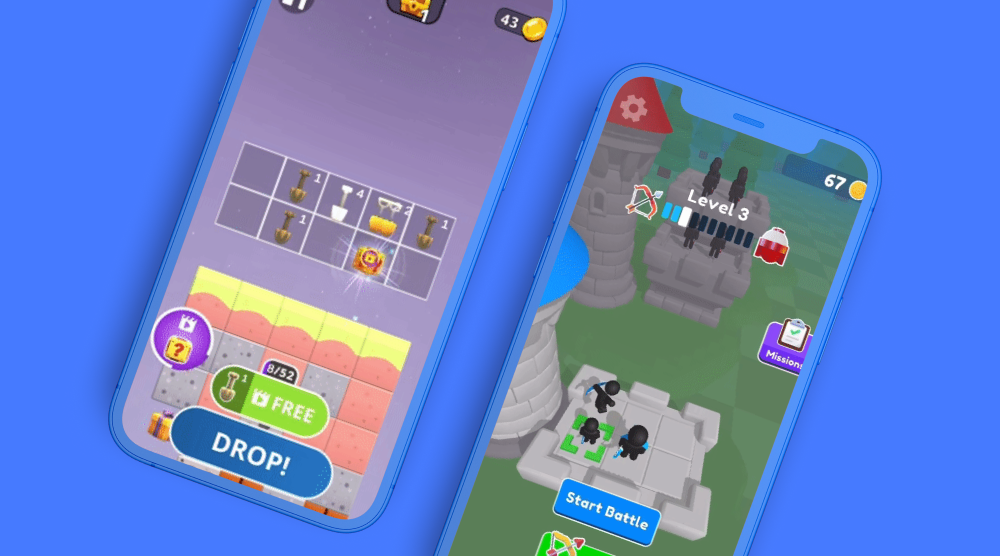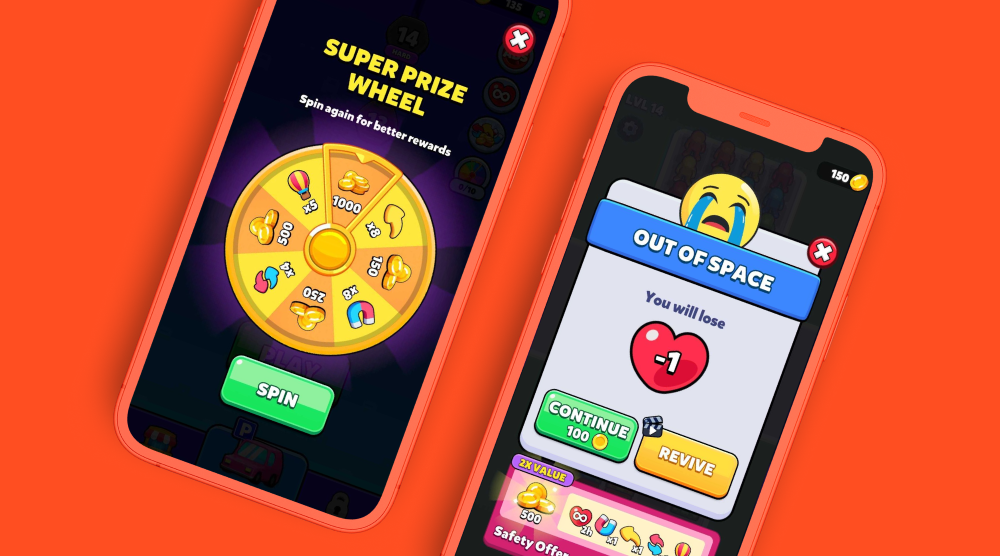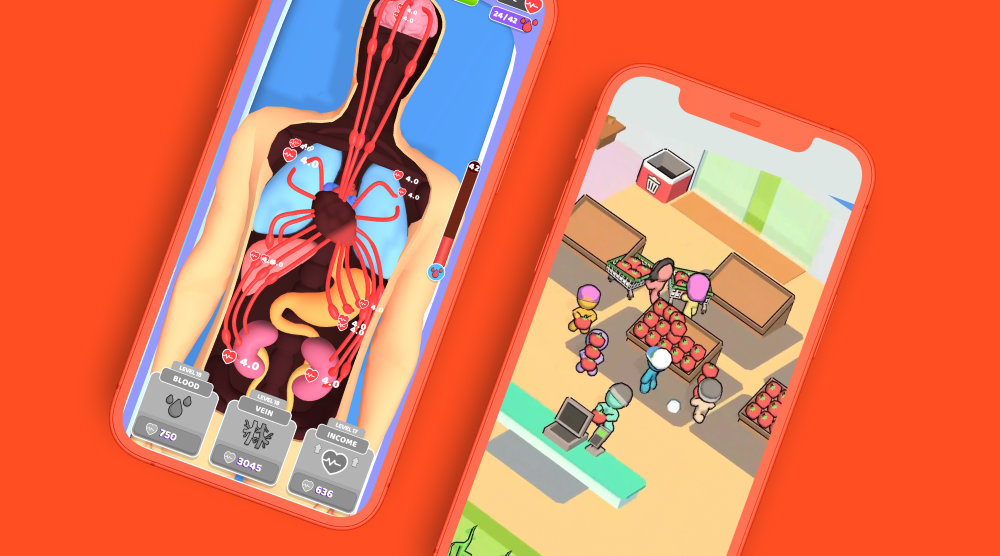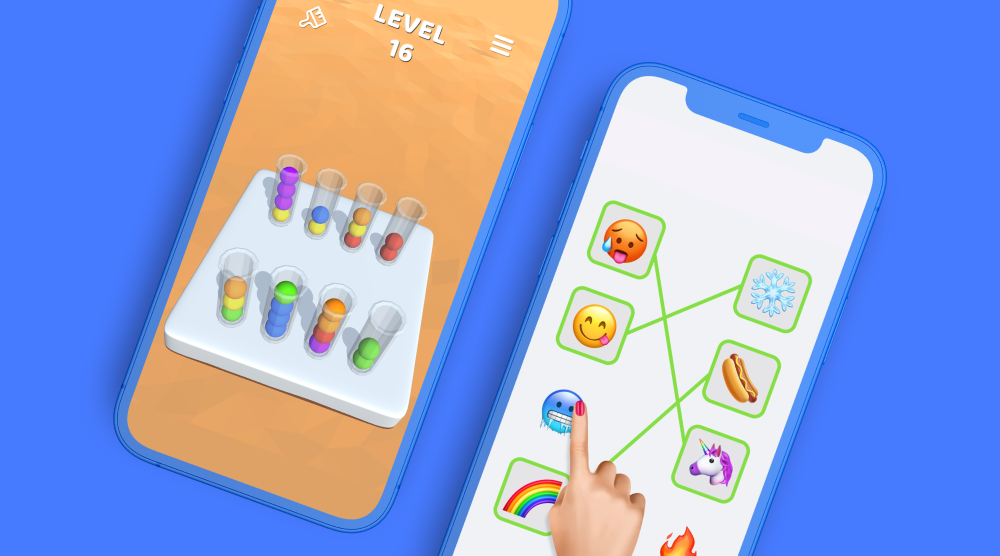Combining engaging mechanics with trending genres can enhance the depth of gameplay and create more opportunities for monetization - which all helps boost LTV. During our Follow the Formula contest, we’re sharing our top mechanic and genre combinations that you can use to build formula games that have higher in-game metrics and profitability potential - and earn serious cash prizes at every step of publishing.
Discover below the best ways to bring an innovative twist to each genre - and get inspired to create a concept that you can submit into the contest for the chance to grow a profitable hit and win bonuses along the way.
Runner games + merge/assembling mechanic
Adding a merging or assembling mechanic to traditional runner games brings an extra layer to gameplay and enhances depth.
1. Give users the opportunity to engage at the pre-level
Before the start of each level, give players the opportunity to engage with the merging or assembly mechanic. For example, show a dedicated screen where players merge or assemble their characters to upgrade their abilities. Just make sure this directly enhances the character’s capabilities - like making them faster, stronger, or more agile. By the time the level starts, users should be able to progress more easily, enhancing their feeling of accomplishment and encouraging them to continue engaging with the pre-level assembling/merging mechanic.
2. Create a dynamic experience at the end of the level
Incorporating a form of end-level engagement, like a mini-game, idle resource management task, or a challenging boss battle can enhance the gameplay experience and keep users playing for longer. Keep in mind that balance is important here - the difficulty of these end-level tasks should be proportionate to the player's capabilities. We suggest implementing a progression system in which users complete 3-4 runner levels before tackling an end-level task - they’ll have enough experience playing the game to understand how to advance, and they’ll be motivated to keep advancing through the levels.
3. Combine mechanics for even more depth
Use both an assembling and a merge mechanic in your runner game to make the gameplay experience even more dynamic. For example, Car Up! by Rollic lets players assemble and customize their cars before each level, while during gameplay they can merge items.
4. Offer in-game collectibles that affect gameplay
During each level of your runner, players should be able to collect items that significantly impact gameplay. These items could directly improve their abilities, for example, aid in defeating the end-level boss, or in the case of an idle arcade mini-game, relate to building or demolishing structures. Tying the collection of items to meaningful outcomes in the game creates more depth and encourages players to engage for longer. For example, in Bullet Stack, the amount of bullets players collect has a direct impact on gameplay. The more they collect, the more damage they can inflict on the building at the end of the level.
Shooter games + merge/assembling mechanic
Merging and/or assembling weapons is a big reason why these mechanics are natural fits for shooter games. Discover the best practices for integrating them into a shooter concept to make the most out of their benefits for in-game metrics and LTV.
1. Diversify the ways users engage with the mechanic
Try implementing the merge or assembling mechanic both at the pre-level and during the level itself. And consider the ways players can engage with the mechanics beyond the expected - for example, assembling weapons is a natural fit for shooter games. But don't be afraid to explore other options, like assembling protective gear, vehicles, or allies like combat drones. This can create a more immersive and diverse gameplay experience.
2. Combine both mechanics
You can use both the merge and assembling mechanics in your game to introduce an additional engagement layer. Consider adding a merge mechanic before the assembly process, like merging different elements or materials that players can use to assemble weapons. Users need to think about what to merge to create the best components for assembly - and then what to assemble to create a powerful weapon.
3. Make an impact on player performance
Give players a reason to engage with the mechanic by linking upgrades, rewards, and bonuses to assembling or merging. This can look like rewarding users with special abilities or higher damage capabilities according to the level of merge they achieve. Or having the quality of the assembled weapon directly influence player performance. Knowing that the results of merging or assembling can have an impact on game performance encourages players to invest time and effort into engaging with the mechanics.
4. Introduce a strategic component
With the merges and assembly mechanics having varying effects on gameplay, players need to consider the strategic benefits of each choice - how they should merge or assemble items based on the current game situation or their preferred style of play (e.g. stealth fighting or using precision weapons that are more challenging).
Puzzle games + merge/assembling mechanic
Puzzle games usually have longer retention and higher LTV already. Adding a merge and/or assembling mechanic is a great way to enhance gameplay and boost these KPIs.
1. Instill a sense of accomplishment and achievement
Players can merge or assemble items in the pre-level or during gameplay to enhance performance or help solve the puzzle. For example, they can assemble items like gears or drills to create a tool that lets them progress faster. Or, users can merge items - like cups of coffee and baked goods - to match customer orders correctly.
2. Make sure it’s on-theme
The ways to use merging or assembly in puzzle can look and feel different from any other genre. In the case of Paper Fold by Good Job Games, players are shown an intact piece of paper, then need to assemble it into a shape by folding in a specific order. Your mechanic should enhance the puzzle game’s theme, whether it’s paper folding, mining, or woodcutting.
3. Evolve with each merge or assembly
Each time that players merge or assemble the same item, it should get increasingly more powerful and offer new benefits - and this evolution should feel natural. For example, users could merge two wooden axes to get an iron axe that lets them cut through stronger trees. Iron is more durable than wood, so this evolution feels intuitive while letting players unlock greater capabilities.
4. Base the mechanics on real life
Building a mechanic that resembles real life can help lower CPI - users can recognize and relate to it more easily. So look for videos that relate to your game’s theme to help you create an assembly or merging mechanic that looks realistic. For example, if you have a puzzle game with a woodcutting theme, look up videos of wood cutting tools to understand how you should implement them into your game.
Idle games + merge/assembling mechanic
Idle games often have higher in-game metrics than other hyper-casual genres. However, the challenge is translating this engagement into LTV when introducing monetization. Introducing a secondary layer through a merge and/or assembly mechanic can boost LTV - all while preserving (or even increasing) playtime and retention.
1. Optimize an in-app purchase and/or rewarded video strategy
Players will usually engage for longer with an idle game that has an additional merge/assembling mechanic. And as they become more engaged, they’ll be more likely to make an in-app purchase or watch a rewarded video to get upgraded capabilities and progress. So optimize your IAP and/or RV strategies to take full advantage of users’ motivation and increase your ARPU.
2. Strike the right balance of difficulty
Merging and assembling can give players more capabilities and help them progress through your game. But, you don’t want them to advance too quickly and get bored with your game - you also don’t want them to find it too challenging. Strike a balance that lets users merge and assemble to almost succeed. They’ll understand they need to continue engaging with the merge/assembling mechanic to earn upgrades and will be encouraged to keep trying.
3. Get the best of both the merging and assembling mechanics
You can try combining merging and assembling mechanics into one idle game. The purpose of using these mechanics is to encourage greater user engagement by helping them progress through the game. Giving them the opportunity to earn upgrades through merge and assembling is a great way to maximize engagement - which can help boost LTV.
4. Split up longer levels with upgrade systems
Level lengths in idle games are usually longer than other genres. Take this as an opportunity to offer mid-level upgrade systems - parts of the level that use an assembly or merge mechanic for players to earn upgrades that help them progress. You can also show rewarded videos or offer IAPs at these times for players to engage with and enhance their capabilities.
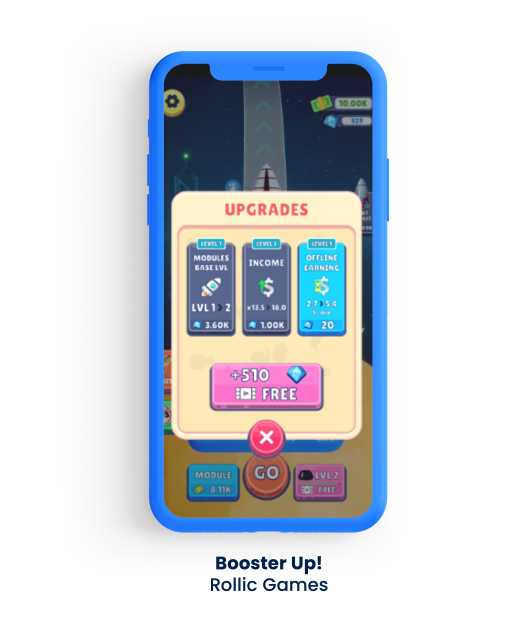
Ready to put our formulas into action and enter the Follow the Formula contest? Remember - huge cash prizes are up for grabs!
Let's put these tips to good use
Publish your game with Supersonic
